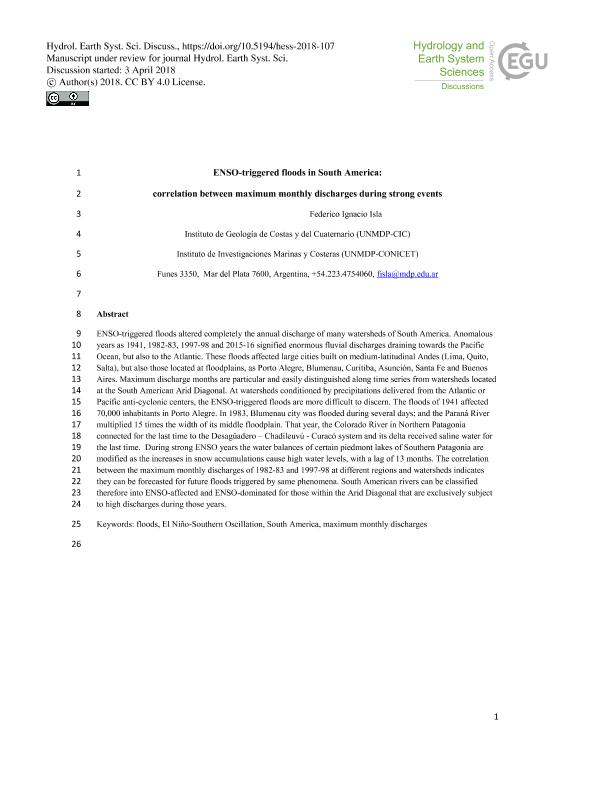Mostrar el registro sencillo del ítem
dc.contributor.author
Isla, Federico Ignacio

dc.date.available
2019-11-26T18:22:13Z
dc.date.issued
2018-04
dc.identifier.citation
Isla, Federico Ignacio; ENSO-triggered floods in South America: correlation between maximum monthly discharges during strong events; European Geosciences Union; Hydrology And Earth System Sciences; 107; 4-2018; 1-13
dc.identifier.issn
1027-5606
dc.identifier.uri
http://hdl.handle.net/11336/90527
dc.description.abstract
ENSO-triggered floods altered completely the annual discharge of many watersheds of South America. Anomalous 9 years as 1941, 1982-83, 1997-98 and 2015-16 signified enormous fluvial discharges draining towards the Pacific Ocean, but also to the Atlantic. These floods affected large cities built on medium-latitudinal Andes (Lima, Quito, Salta), but also those located at floodplains, as Porto Alegre, Blumenau, Curitiba, Asunción, Santa Fe and Buenos Aires. Maximum discharge months are particular and easily distinguished along time series from watersheds located at the South American Arid Diagonal. At watersheds conditioned by precipitations delivered from the Atlantic or Pacific anti-cyclonic centers, the ENSO-triggered floods are more difficult to discern. The floods of 1941 affected 70,000 inhabitants in Porto Alegre. In 1983, Blumenau city was flooded during several days; and the Paraná River multiplied 15 times the width of its middle floodplain. That year, the Colorado River in Northern Patagonia connected for the last time to the Desagûadero Chadileuvú - Curacó system and its delta received saline water for the last time. During strong ENSO years the water balances of certain piedmont lakes of Southern Patagonia are modified as the increases in snow accumulations cause high water levels, with a lag of 13 months. The correlation between the maximum monthly discharges of 1982-83 and 1997-98 at different regions and watersheds indicates they can be forecasted for future floods triggered by same phenomena. South American rivers can be classified therefore into ENSO-affected and ENSO-dominated for those within the Arid Diagonal that are exclusively subject to high discharges during those years.
dc.format
application/pdf
dc.language.iso
eng
dc.publisher
European Geosciences Union
dc.rights
info:eu-repo/semantics/openAccess
dc.rights.uri
https://creativecommons.org/licenses/by-nc-sa/2.5/ar/
dc.subject
floods
dc.subject
El Niño-Southern Oscillation
dc.subject
South America
dc.subject
maximum monthly discharges
dc.subject.classification
Oceanografía, Hidrología, Recursos Hídricos

dc.subject.classification
Ciencias de la Tierra y relacionadas con el Medio Ambiente

dc.subject.classification
CIENCIAS NATURALES Y EXACTAS

dc.title
ENSO-triggered floods in South America: correlation between maximum monthly discharges during strong events
dc.type
info:eu-repo/semantics/article
dc.type
info:ar-repo/semantics/artículo
dc.type
info:eu-repo/semantics/publishedVersion
dc.date.updated
2019-10-24T19:38:21Z
dc.identifier.eissn
1607-7938
dc.journal.volume
107
dc.journal.pagination
1-13
dc.journal.pais
Austria

dc.journal.ciudad
Vienna
dc.description.fil
Fil: Isla, Federico Ignacio. Consejo Nacional de Investigaciones Científicas y Técnicas. Centro Científico Tecnológico Conicet - Mar del Plata. Instituto de Investigaciones Marinas y Costeras. Universidad Nacional de Mar del Plata. Facultad de Ciencias Exactas y Naturales. Instituto de Investigaciones Marinas y Costeras; Argentina
dc.journal.title
Hydrology And Earth System Sciences

dc.relation.alternativeid
info:eu-repo/semantics/altIdentifier/url/https://www.hydrol-earth-syst-sci-discuss.net/hess-2018-107
dc.relation.alternativeid
info:eu-repo/semantics/altIdentifier/doi/https://doi.org/10.5194/hess-2018-107
Archivos asociados
